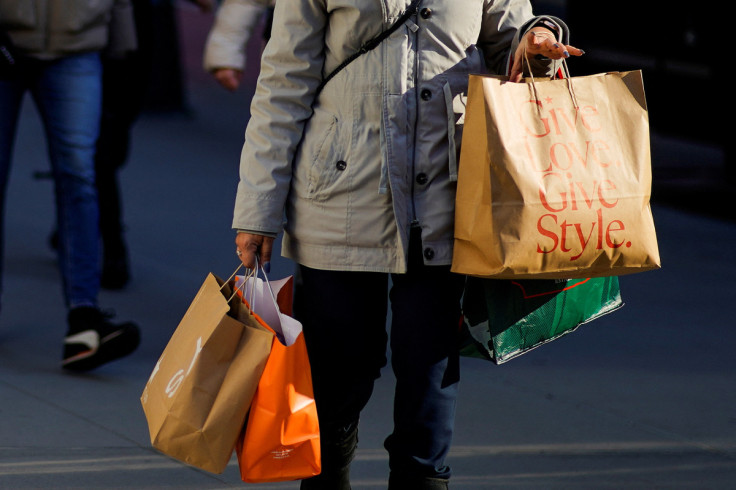U.S. Consumer Confidence Ebbs; House Price Inflation Slows Further

U.S. consumer confidence unexpectedly fell in February, with the decrease concentrated among lower-middle income households, though Americans grew more upbeat about the labor market.
The survey from the Conference Board on Tuesday also showed consumers apprehensive about buying big-ticket items like motor vehicles and household appliances over the next six months. But the correlation between confidence and consumer spending has been weak. Americans have maintained spending despite worries about the future, thanks to a strong labor market.
"Households are likely cautious given inflation is still elevated and borrowing costs are rising," said Rubeela Farooqi, chief U.S. economist at High Frequency Economics in White Plains, New York. "But they are continuing to spend for now, owing to strong job growth that is restoring incomes."
The Conference Board's consumer confidence index dropped to 102.9 this month from 106.0 in January. Economists polled by Reuters had forecast the index at 108.5. The second straight monthly decline mostly reflected pessimism among consumers with annual incomes in the $35,000 to $50,000 range.
There were also decreases among other income groups, with the exception of the $25,000-$34,999 income bracket. Confidence dropped among consumers in the 35 to 54 age group.
The broad decline in confidence is in stark contrast with the University of Michigan sentiment index, which increased to a 14-month high in February.
"We are more inclined to take signals from the University of Michigan index, particularly on the path of consumer spending in the months ahead, as it has historically been a more-reliable indicator of future consumer spending trends," said Colin Johanson, an economist at Barclays in New York.
Consumer spending increased by the most in nearly two years in January, driven by a surge in wage gains. Spending is likely to remain supported in the months ahead as the Conference Board survey showed the share of consumers viewing jobs as "plentiful" rising back to levels seen in the spring of last year.
As a result, the survey's so-called labor market differential, derived from data on respondents' views on whether jobs are plentiful or hard to get, rose to 41.5, the highest in nearly a year, from 37 in January. This measure correlates to the unemployment rate from the Labor Department. The jobless rate of 3.4% in January was the lowest in more than 53 years.
Stocks on Wall Street were lower. The dollar was steady against a basket of currencies. U.S. Treasury prices fell.
TIGHT LABOR MARKET
Labor market tightness and stubbornly high inflation have stoked fears that the Federal Reserve could continue raising interest rates into summer.
The Fed is expected to deliver two additional rate hikes of 25 basis points in March and May. Financial markets are betting on another increase in June. The U.S. central bank has raised its policy rate by 450 basis points since last March from near zero to a 4.50%-4.75% range.
Consumers' 12-month inflation expectations fell to 6.3% from 6.7% last month. With price pressures still strong, fewer consumers planned big-ticket purchases and travel over the next six months. They were also less enthusiastic about buying a home, especially with mortgage rates resuming their ascent.
Higher mortgage rates and home prices have pushed many potential buyers to the sidelines. There are, however, signs that housing affordability is starting to gradually improve.
The S&P CoreLogic Case Shiller national home price index, covering all nine U.S. census divisions, increased 5.8% year-on-year in December, a second report showed on Tuesday. That was the smallest annual gain since mid-2020 and followed a 7.6% rise in November. Prices increased 5.8% in 2022, pulling back from 2021's record-setting 18.9% gain.
The slowdown was centered in the West, where annual house prices rose 1.2%. Prices fell in Francisco and Seattle, but rose moderately in Portland. Price growth remained strong in the South, with double-digit gains in Miami, Tampa and Atlanta.
Slowing overall house price inflation was corroborated by a third report from the Federal Housing Finance Agency on Tuesday showing home prices advanced 6.6% in the 12 months through December, the smallest rise since June 2020, after increasing 8.2% in November. They increased 6.6% in 2022 compared to a gain of 18.0% in 2021.
While higher mortgage rates are hurting demand and cooling house price inflation, the FHFA noted that "these negative pressures were partially offset by historically low inventory."
A fourth report from the Commerce Department showed the goods trade deficit widened 2.0% to $91.5 billion in January, leaving trade on track to have little or no impact on GDP growth early in the first quarter.
Graphic: Trade balance

A smaller trade deficit was one of the contributors to the economy's 2.7% annualized growth pace in the fourth quarter. The other boost to growth came from inventories.
Graphic: Wholesale inventories

Wholesale inventories fell 0.4% last month after gaining 0.1% in December, the Commerce Department also showed. Stocks at retailers rose 0.3% after increasing 0.4% in December.
© Copyright Thomson Reuters 2024. All rights reserved.





















